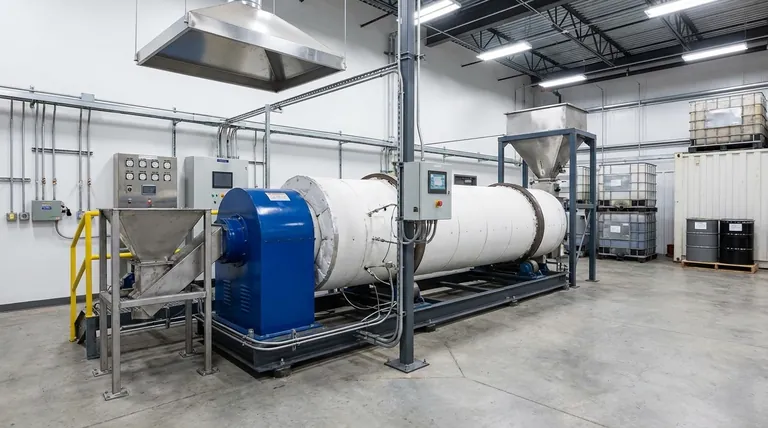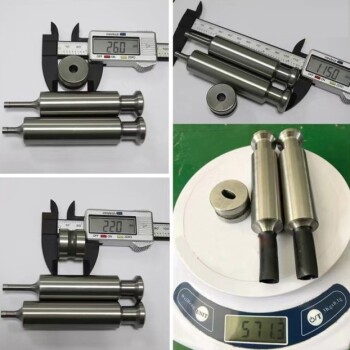In essence, pyrolysis of lignocellulosic materials is a thermochemical process that breaks down plant-based biomass, like wood or agricultural waste, by heating it to high temperatures in an environment with little to no oxygen. Instead of burning, this process chemically decomposes the material into three distinct and valuable products: a liquid known as bio-oil, a solid called bio-char, and a combustible gas mixture called syngas.
This process is not simply waste destruction; it is a strategic method for converting low-value, abundant biomass into a portfolio of higher-value energy and material outputs. Success, however, depends entirely on precise control over the feedstock and processing conditions.

The Core Mechanism: Deconstructing Biomass
Pyrolysis is a carefully controlled thermal reaction. Understanding its core components is key to appreciating its potential and its limitations.
The Role of Heat and Oxygen Deprivation
The defining characteristic of pyrolysis is the absence of oxygen. Unlike combustion (burning), which is an oxidation reaction that releases energy primarily as heat, pyrolysis uses external heat to break complex organic polymers into smaller, more useful molecules.
This "thermochemical decomposition" prevents the biomass from simply turning to ash, instead preserving its chemical components in new liquid, solid, and gaseous forms.
Lignocellulosic Feedstocks: The Raw Material
Lignocellulosic materials are the structural parts of plants and are the most abundant form of biomass on Earth. This includes wood, forestry residues, agricultural straws, and grasses.
While abundant, this biomass is often difficult to use directly as a high-density energy source. Pyrolysis serves as a conversion technology to unlock its stored chemical energy.
The Pre-processing Step: Densification
To improve efficiency, raw biomass is often pre-processed through densification. This involves compressing the material into uniform pellets or briquettes.
This step is critical for large-scale operations. Densified biomass is far easier and cheaper to transport, store, and feed consistently into a pyrolysis reactor, leading to a more stable and predictable process.
The Three Key Products of Pyrolysis
The output of pyrolysis is not a single product but a slate of three co-products. The relative yield of each depends heavily on the specific process parameters, such as temperature and heating rate.
Bio-oil: The Liquid Fuel Component
Bio-oil is a dark, viscous liquid sometimes referred to as pyrolysis oil or bio-crude. It is a complex mixture of water and hundreds of different organic compounds.
It can be combusted directly in industrial boilers for heat and power, or it can be upgraded through further refining into transportation-grade biofuels and other valuable chemicals.
Bio-char: The Solid Carbon Residue
Bio-char is the stable, carbon-rich solid that remains after pyrolysis. It is visually similar to charcoal.
Its primary application is as a soil amendment. When added to soil, bio-char can improve water retention, increase nutrient availability, and provide a habitat for beneficial microbes. It is also a highly effective method of long-term carbon sequestration.
Syngas: The Gaseous Fuel
Syngas, or synthesis gas, is a mixture of combustible gases, primarily carbon monoxide (CO) and hydrogen (H₂), along with other non-combustible gases like carbon dioxide.
This gas can be captured and combusted on-site to provide the heat needed to run the pyrolysis process itself, making the system more energy-efficient. Any excess syngas can be used to generate electricity or steam.
Understanding the Trade-offs and Challenges
While powerful, pyrolysis is a complex industrial process with specific technical hurdles that must be managed for successful implementation.
High Energy Input
The process is fundamentally endothermic, meaning it requires a significant input of energy to maintain the high temperatures needed for decomposition. A well-designed system must be efficient enough to generate a net positive energy balance, often by using the syngas it produces.
Process Control is Critical
Pyrolysis is not a "one size fits all" technology. The final product distribution is extremely sensitive to operating conditions. For example, fast pyrolysis at moderate temperatures favors bio-oil production, while slow pyrolysis at lower temperatures maximizes the yield of bio-char.
Bio-oil Quality and Instability
Raw bio-oil is not a "drop-in" replacement for petroleum fuels. It is typically acidic, corrosive, and chemically unstable over time. It requires a secondary process known as upgrading to remove oxygen and improve its properties before it can be used in standard engines or refineries.
Making the Right Choice for Your Goal
The optimal pyrolysis strategy is determined by your end objective. By tuning the process, you can prioritize the output that delivers the most value for your specific application.
- If your primary focus is renewable energy generation: Prioritize fast pyrolysis conditions that maximize the yield of bio-oil and syngas for use in boilers and generators.
- If your primary focus is sustainable agriculture and carbon sequestration: Use slow pyrolysis to maximize the production of high-quality, stable bio-char for use as a soil amendment.
- If your primary focus is advanced biofuels or green chemicals: Target a high yield of bio-oil and invest in the necessary downstream upgrading technologies to refine it into a finished product.
By understanding the interplay between feedstock, process, and products, you can strategically direct the conversion of biomass to meet specific energy, agricultural, or chemical goals.
Summary Table:
| Product | Description | Primary Uses |
|---|---|---|
| Bio-oil | Dark, viscous liquid from biomass decomposition | Industrial fuel, upgraded biofuels, chemicals |
| Bio-char | Solid carbon-rich residue | Soil amendment, carbon sequestration |
| Syngas | Combustible gas mixture (CO, H₂) | Process heat, electricity generation |
Ready to transform your biomass into valuable products? At KINTEK, we specialize in high-quality lab equipment and consumables for pyrolysis research and development. Whether you're optimizing bio-oil yields, producing soil-enhancing bio-char, or generating syngas for energy, our precise reactors and analytical tools help you control every variable for maximum efficiency. Let our experts support your renewable energy or sustainable agriculture goals. Contact us today to discuss your specific pyrolysis needs!
Visual Guide

Related Products
- Electric Rotary Kiln Small Rotary Furnace Biomass Pyrolysis Plant
- Electric Rotary Kiln Continuous Working Small Rotary Furnace Heating Pyrolysis Plant
- Vacuum Sealed Continuous Working Rotary Tube Furnace Rotating Tube Furnace
- High Temperature Muffle Oven Furnace for Laboratory Debinding and Pre Sintering
- Non Consumable Vacuum Arc Induction Melting Furnace
People Also Ask
- What are the different types of pyrolysis machines? Choose the Right System for Your Output
- How is energy converted into biomass? Harnessing Nature's Solar Power for Renewable Energy
- What is the process of biomass fast pyrolysis? Turn Biomass into Bio-Oil in Seconds
- What are the components of biomass pyrolysis? A Complete Guide to the System, Products, and Process
- What is a disadvantage of biomass energy? The Hidden Environmental and Economic Costs



















